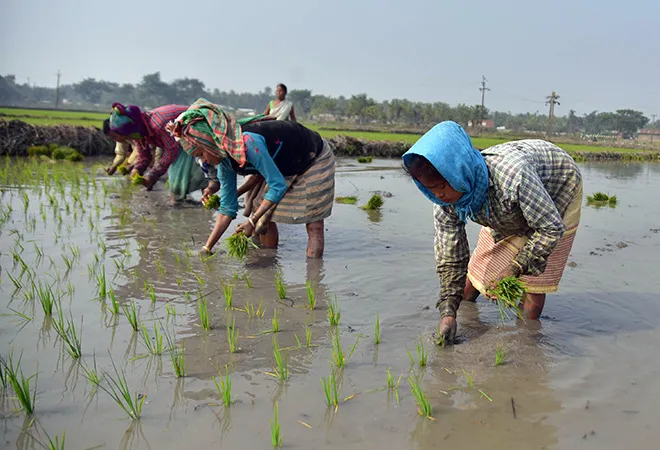-
CENTRES
Progammes & Centres
Location

Image Source: Getty
India’s Union Budget 2021 bore a unique burden of expectation—to revive demand and put a battered economy back on a robust growth trajectory, all while making provisions to battle the ongoing pandemic and manage an unenviable fiscal deficit. The Budget has revealed a clear policy narrative and macroeconomic roadmap of how the government intends to go about achieving these aims.
Over the past few months, India has seen a profit-led formal sector-driven recovery. The bulls have dominated the stock market, driven by the growth of India’s large firms and the news of a vaccine rollout. The Budget didn’t let the market down—it’s clear policy thrusts on infrastructure, privatisation, health and fiscal transparency set the Sensex soaring to its second-highest rise ever of 2,315 points. Equally stark, however, have been the policy areas conspicuous by their absence. The social sector, education and employment generation have been given short shrift by the Budget this year. This, when India finds itself in the midst of a severe livelihoods crisis, with a shrunken informal sector and consequently inflated self-employment, coupled with a rise in poverty and inequality in the country. Azim Premji University’s analysis of CMIE data has indicated that self-employment rose to 64 percent by August 2020, from 48 percent in December 2019. Around 59 percent of workers aged 15-24 years lost employment and only 15 percent of women employed in December 2019 were able to retain their jobs. Given this context, the Budget was expected to alleviate financial distress, and put money in the hands of the poor through an immediate fiscal stimulus. It has taken a somewhat different tack.
The Budget has laid an emphasis on capital expenditure, and the creation of long-term assets and avenues of employment through a boost in manufacturing through production-linked incentives, establishment of textile parks, a boost to solar equipment manufacturers and industries such as ship recycling. These are laudable yet long-term plans, which will generate employment and boost consumption only over the next five years, and have come at the cost of essential revenue expenditure required today.
The fiscal deficit number of 9.5% of GDP, belies the fact that additional spending proposed in FY 2021-22 is only INR 33,000 crore above revised estimates in 2020-21. Additionally, the limited social sector expenditure proposed for FY 2021-22 has, unfortunately, been allocated to schemes which have not delivered very well in the past, at the expense of tried-and-tested performers like the MGNREGA. Almost half of the INR 1,31,531 crore allocation for the Agriculture and Farmers’ Welfare Ministry this fiscal, has been marked for the PM-KISAN scheme. However, due to a hasty rollout, this scheme is poorly targeted and implemented; in its focus on land-owning farmers, it excludes tenants, sharecroppers and landless farmers who constitute approximately 55 percent of the total agricultural workforce. It also suffers from a lack of quality data, due to outdated land records and inconsistent Aadhar data. Similarly, the Budget has sought to promote the Ujjwala scheme, proposing to extend its cover to one crore more beneficiaries this year. Ujjwala has also failed to deliver on actual outcomes—research indicates that the beneficiaries of the Ujjwala programme have not adopted LPG on a regular basis, due to hefty refilling costs (belated subsidies are unviable for cash-strapped households), and an absence of incentives to promote use. These schemes, therefore, required a rejig in design and implementation before their extension.
MGNREGA, on the other hand, urgently needed the cash. The scheme was a lifesaving buffer for the rural economy over the past year when the pandemic hit hardest. The tracker operated by the People’s Action of Employment Guarantee showed that between April and September, an unprecedented 8.3 million new MGNREGA job cards were issued, and 0.2 million households had availed their 100 days of annually guaranteed employment, as early as July. Demand for work outstripped MGNREGA’s budgetary allocations, and pending liabilities under the scheme were as high as INR 6430 crore in quarter three of FY 2019-20. Actual expenditure on the scheme in 2020-21 soared to INR 1,11,500 crore. It is, therefore, inexplicable that the allocation for the scheme was shorn to INR 73,000 crore this year, when the livelihoods crisis that prompted an increase in revised expenditures last year, is nowhere close to over. Even the Pradhan Mantri Rojgar Protsahan Yojna—a scheme meant to incentivise new employment in the formal sector with its attendant social security benefits—has seen allocations cut from INR 2550.00 crore to INR 900 crore in 2021-22.
MGNREGA, on the other hand, urgently needed the cash. The scheme was a lifesaving buffer for the rural economy over the past year when the pandemic hit hardest
The PM Employment generation programme and other credit support schemes for MSMEs have seen a substantial boost, receiving INR 12,499.70 crore this year (the RE for the last FY was INR 2,227.45 crore). MSMEs are major employment creators in the Indian economy, therefore, this is a heartening development. However, the boost in allocations for the PM Employment Generation Programme and entrepreneurship and skill development for MSMEs remains to be justified, as their implementation was shaky in 2020-21 and their expenditures were therefore revised downwards. Meanwhile, the much-vaunted and successful Credit Linked capital subsidy and technology upgradation scheme meant to boost MSME competitiveness has received a disappointingly meagre INR 315.31 crore this year.
The Budget made a passing mention of One Nation One Ration Card but other than that, it held no surprises for unorganised workers and migrant workers in particular. The announcement of minimum wage across categories and coverage by the Employees State Insurance Corporation (ESIC) is laudable, and has been alluded to by the Finance Minister in the past. The data portal for unorganised workers is an important beginning—our welfare system is plagued by a lack of reliable statistics on the sector—but long-term and potentially amorphous in nature.
The Budget made a passing mention of One Nation One Ration Card but other than that, it held no surprises for unorganised workers and migrant workers in particular. The announcement of minimum wage across categories and coverage by the Employees State Insurance Corporation (ESIC) is laudable
There has also been no real increase in budgetary allocation towards education and the novel suggestion of working to strengthen 15,000 schools under the National Education Policy appears to deal a blow to the inclusive spirit enshrined by the NEP. Following a year where all schools in the country remained shut for the entire year, revealing and sharpening India’s digital divide and causing learning outcomes to fall dramatically, this lacuna in the budget is a true tragedy. So is the cut in nutrition allocations to INR 2,700 crore (from last year’s allocation of INR 3,700 crore), at a time when child malnutrition numbers in the NFHS-5 stunned the country and a thrust on mid-day meals and the integrated child development services (ICDS) was expected.
Budget 2021 has certainly provisioned for India’s economic growth and a conducive investment and disinvestment environment this year. However, it also leads us to believe that this growth will continue to be led by the formal economy and driven by the consumption of a minuscule proportion of the population, to the detriment of inclusivity and the country’s long-term prospects.
The views expressed above belong to the author(s). ORF research and analyses now available on Telegram! Click here to access our curated content — blogs, longforms and interviews.

Sangeet Jain was Junior Fellow at ORF. Her research focus is on employment and the future of work
Read More +